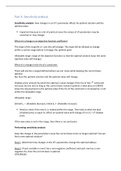Part 4: Sensitivity analysis
Sensitivity analysis: how changes in an LP’s parameter affects he optimal solution and the
optimal value.
ð Important because in a lot of practical cases the values of LP parameters may be
uncertain or may change.
Effect of a change in an objective function coefficient:
The slope of the isoprofit or -cost line will change. The slope will be allowed to change
within a certain range before it changes the optimal point.
Allowable range: range of the objective function so that the optimal solution stays the same
(optimal value will change)
Effect of a change in the rhs of a constraint:
There will also be a ranged defined where we can move while keeping the current basis
optimal.
But here the optimal solution and the optimal value will change.
Shadow price: amount by which the optimal z-value changes if the rhs of the 𝑖 ‚ƒ constraint
increases by one unit as long as the current basis remains optimal. (=dual price on LINDO)
Gives the improvement in the optimal value if the rhs of the constraint is increased by 1 unit
within the allowable range.
Allowable range:
[Initial 𝑏) − allowable decrease; Initial 𝑏) + allowable increase]
ð Need to check if the new 𝑏) is indeed within the range. Then look at what the dual
(shadow) price is equal to: effect on optimal value with change of x in 𝑏) = x*shadow
price
If the new value is not in the range, then there is no conclusion.
Performing sensitivity analysis
Does the change in the parameters cause the current basis to be no longer optimal? Can we
find a new optimal solution?
Step 1: determine how changes in the LP’s parameters change the optimal tableau
Step 2: If each variable in row 0 has a non-negative coefficient and each row has a non-
negative rhs, then the current basis is optimal
OTHERWISE:





